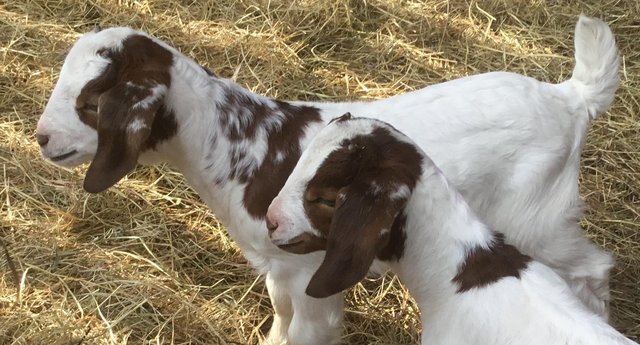

It is important to take good care of kids so as to reduce mortalities and improve kid growth rate. A reduction in kid mortality translates into an increase in flock size and consequently the increase in offtake.
Kidding Seasons
– Kidding should coincide with times of abundant feed availability so that the does will be producing enough milk for the survival of the kid.
– This is usually in the December to February period.
– Sometimes goats may kid when the condition of the range is not good that is in winter. In such cases it is always important to make sure that the doe is adequately fed and is producing enough milk.
Kid Rearing
1. Preparation
– Kidding area should be clean with dry bedding (Stover or hay).
– The doe may be kept in the kidding area for a few days before kidding.
The signs of a goat that is about to kid are:
a. Restlessness
b. Separating itself from the flock
c. Discharge of mucus from the vulva
The advantage of separating pregnant does from the rest of the flock is to ensure undisturbed birth process and creates good bonding between the doe and kid.
2. At Birth
To allow bonding the doe must clean and groom her kids and remain undisturbed for two to four hours. When to intervene in the birth process:
– When there is mal-presentation or difficulties in kidding.
– When the kid does not bleat or breathe because the doe failed to clean it, remove the membrane over the nostrils.
– Cutting the navel and application of iodine. Iodine application is not necessary if bedding is clean.
– When there is no bonding between the doe and the kid
3. Kid Housing
Keep the kids at home for the first few weeks to about one month (especially if the does have to travel long distances to browse and water). The kids require warm and dry conditions during their first four weeks of life. Housing should protect kids from heat, cold or even spread of diseases among kids. An example of kid housing is the Kid boxes. The kid box has the following: made of wood or bamboo measuring, 500 – 600mm long, 400 – 500mm wide and 300 – 400mm deep. Bedding in the box should be kept clean and fresh. This makes it easy to detect diarrhoea. The kid can be kept in the box for three days and moved thereafter.
4. Feeding Kids
– Kids should suckle the first milk (colostrum-cinsema) within the first six hours of birth which is rich in antibodies that increase the immunity of the kid. If the doe is not producing enough milk for her kid, fostering or bottle feeding is recommended.
– From about 3 weeks of age kids start nibbling grass and leaves. This is important for rumen development.
– They should be allowed to browse/graze from no later than one month. Effective grazing and browsing starts at 6 – 7 weeks.
5. Identification
It is important to have identifications for individual animals as this makes record keeping easier. There are a number of methods that can be used. These include ear tagging, ear notching and attaching names to animals. It is also a government requirement that all the animals have standard identification for traceability when exporting livestock and livestock products.
6. Health Care in Kids
– A clean environment will reduce the incidence of diseases. A farmer should always be on the lookout for diarrhoea & for respiratory problems – coughing or nasal discharge.
– Make sure kids get colostrum within six hours of birth
– Make sure bedding is clean and dry
– Do not confine many kids in a small area
– Avoid damp conditions and excessive heat or cold
– Avoid overfeeding kids with milk as this result in scours.
To improve the general health of the kids ensure the following; to the whole flock:
– Dry sleeping places
– Clean drinking water (about 5litres per animal per day)
– Adequate feeding (3 – 5% of their body weight per day)
– Control of internal and external parasites
7. Predation
– Ensure that the kids are housed to protect them from being eaten by jackals, eagles and other dangerous animals.
– Do not allow kids to browse in dangerous places unattended
8. Weaning
– This should be done when the kids are hundred days old on average and weighing between 8 – 12 kilograms
– The most common weaning method in goats is complete separation of the kids and the does. It is however critical to vaccinate the kids and the does against pulpy kidney (PK) just before weaning as this stresses them, making them vulnerable to PK.
– Weaning enables the does to be in good body condition in preparation for the next mating season
9. Castration
This is the severing or cutting of the spermatic cords so that the animal cannot mate with the females. Castration improves the quality of meat by reducing the characteristic smell of the entire male. There are three main methods of castration used in goats i.e. the rubber ring, knife/razor and burdizzo.
 Contact Jaguza Support
Contact Jaguza Support